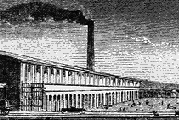|
What are the empirical implications of the Solow-Swan growth model? The first thing to notice is that the population growth rate "dictates" the steady-state growth rates of all the variables in the economy. In other words, at steady-state, all level variables -- output, Y, consumption, C, capital, K, and labor, L -- grow at the same natural rate n. If there is depreciation, they all grow at the same rate n+d . As a result, all the per capita ratio variables -- output per person, y, capital per person, k and consumption per person, c -- do not grow at all. They are constant over time. The policy implications are intriguing. If, at steady-state, we wish to change the rate of growth of any of the level terms, then population growth must change. A change in n implies a change in the required investment line as we see in Figure 1 (n1 > n2) and thus an accompanying movement in the steady-state ratio. So, a change in n changes the growth rates of the level variables but the per capita ratios will, once the new steady state is achieved, remain constant.
This leads us to our second point, the Solowian paradox of thrift. This claims that a permanent change in the rate of savings, s, will not permanently change the economy's growth rate. For instance, an increase in the savings rate (from s1 to s2 in Figure 2), will "swing" the investment curve up, so that we move from the steady-state ratio k1* to the new steady-state ratio k2*. Now, before this shift, all level variables were growing at the rate n. Immediately after the change in the savings rate, capital grows a little bit faster than n, so that k increases from k1* (and output and consumption grow a bit faster too). But as k approaches k2*, the growth rate of capital slows down. When we are at k2*, capital growth (and output and consumption growth) returns to n. So increasing the savings rate permanently will only increase growth rates temporarily. In the longer run, it will have no effect on growth rates.
Associated with this is also the paradox of output, i.e. a country which has a "higher" production function, ¦ (k), will also fail to permanently increase growth rates. To see this, go through the same exercise in Figure 2, but leave s the same and change only ¦ (k) -- the results are almost geometrically identical. Intuitively, one can think of the Solow-Swan model as a person ("capital") attempting to run on a treadmill ("labor"). The growth of capital is the speed of the runner, while the growth of labor is the speed of the treadmill. We have a "steady-state" if the runner manages to stay in the same place. If he runs too slow, then he will fall behind (k declines); if he runs too fast, he will move forward (k rises). Thus, in order to stay in the same place, capital has to run exactly as fast as the treadmill. Anything that increases the speed of the treadmill (a rise in n or d), forces capital to run faster just to stay in the same place. Stretching the analogy, the savings rate merely determines where on the treadmill a person will be running-in-place (close to the front, in the middle, close to the back, etc.), but regardless of where he chooses to be on the treadmill, he still has to run at the same speed. This result is "paradoxical" because one of the old saws of development theory was that increasing the savings rate would accelerate growth. W. Arthur Lewis (1954, 1955) was one of the primary proponents of this idea. As he writes "the countries which are now relatively developed have at some time in the past gone through a rapid acceleration in the course of which their rate of net investment has moved from 5 per cent [of national income] or less to 12 per cent or more" (Lewis, 1955, p.208). Consequently, "The central problem in the theory of economic growth is to understand the process by which a community is converted from being a 5 per cent to a 12 per cent saver." (1955, p.226), However, Lewis relied on Classical growth theory and the Harrod-Domar model to derive his conclusion. But the Solow-Swan model tells us is that the Lewis thesis is only temporarily correct, i.e. there is a short-run acceleration in growth, but in the long-run, growth settles down once again to its previous rate. A third thing that should be noticed from Figure 2 is that steady-state growth is, in general, consumption inefficient. In other words, the economy's steady-state does not necessarily yield the highest consumption per capita forever. In Figure 2, notice that c1* > c2*. So if we begin with savings propensity s2, steady state k2* rules and consumption per capita is c2*. Clearly, the steady-state k2* is not the maximum consumption possible. But recall that steady-states are stable, so there are no inherent economic reasons to move away from this inefficient position. If, and this is a big if, everyone in the economy could somehow collectively decide to decrease the savings rate from s2 to s1, then per capita consumption could increase permanently from c2* to c1*. Of course we obtain this because of the way we drew our diagram. It is conceivable that decreasing s might lead to lower c, for instance. But the principle should be clear: it is quite possible that the steady-state we end up at will be consumption inefficient in the sense that somehow changing the propensity to save will improve consumption per capita permanently. We shall return to this point when discussing "optimal growth". It shall also crop up again when discussing monetary growth models, as consumption-inefficiency makes growth theory amenable to government policy.
|
All rights reserved, Gonšalo L. Fonseca



